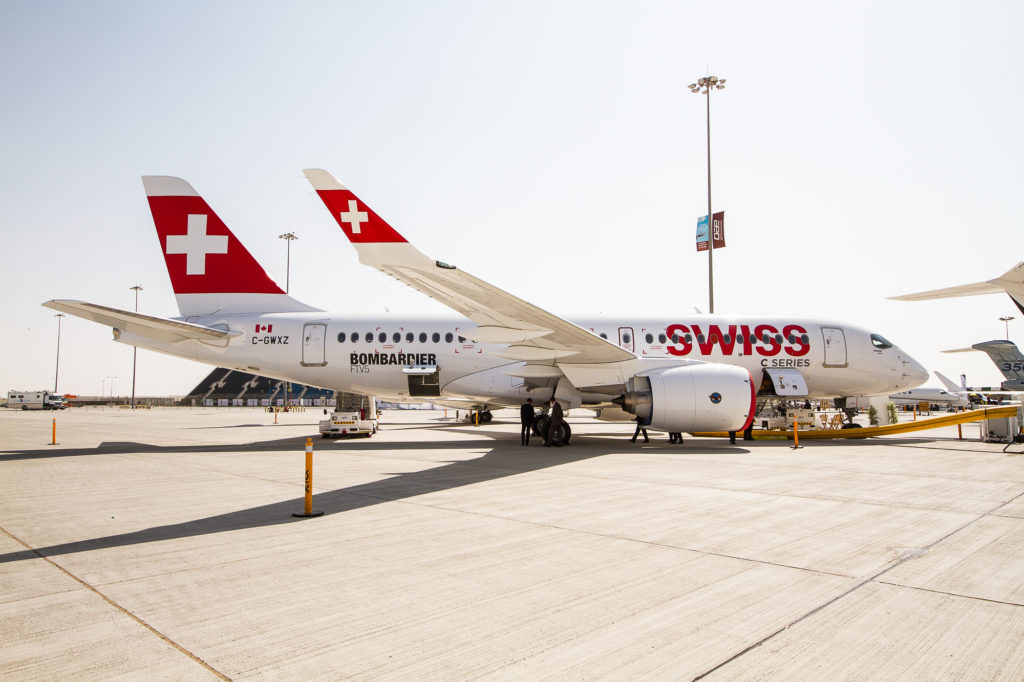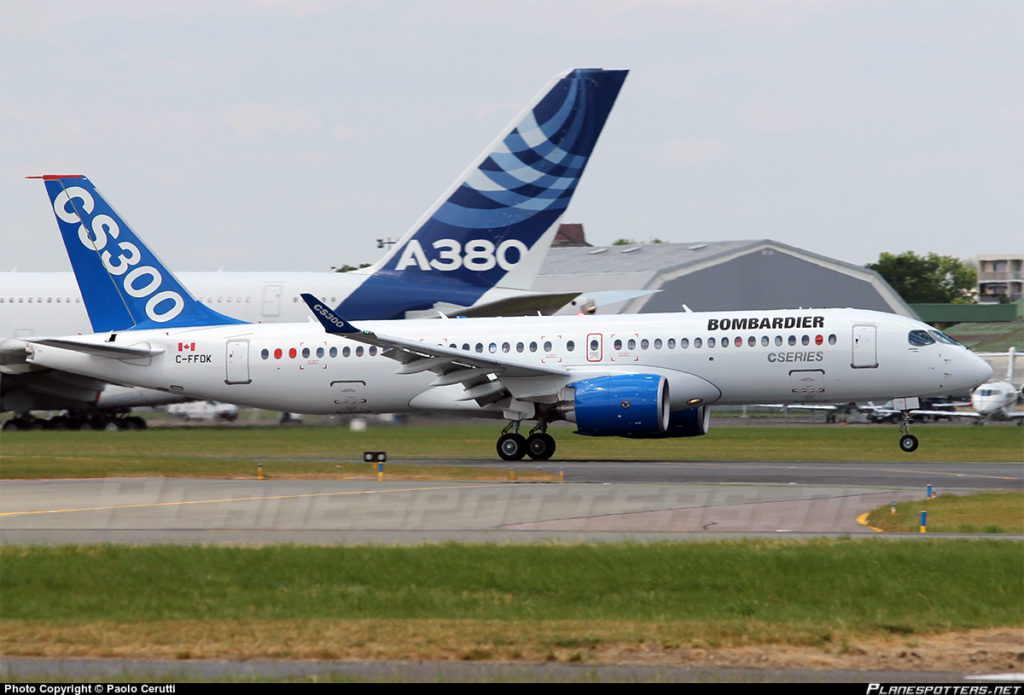There is a new aircraft on the block: the CS100. The CS100 and its sister aircraft, the CS300, are part of the CSeries aircraft family by Bombardier. These narrow bodies were designed to compete with the biggest best sellers: the A320 and B737 series. In the aerospace industry this is possibly one of the hardest challenges. Only one company has ever managed to do it: Airbus. It was back when Boeing had total hegemony over the market and did not take Airbus seriously. What a huge mistake that was- Airbus managed to sell its aircraft and thirty years later, it is now selling more narrow bodies than Boeing on a yearly basis. Airbus having the experience and Boeing having been duped already once, both companies are not about to let Bombardier off the hook so easily.
The CSeries
Officially, the CSeries program started in July 2004 with Bombardier announcing the development of a new narrow body aircraft. This aircraft would have the capacity to transport from 100 to 130 passengers. With this capacity it would be a competitor to the lower tier B737 and A320 series aircraft. The initial plans were received sceptically by airlines which did not order any. A lack of experience coupled with a lack of ambition did not help convince airlines.
The program was therefore restarted in January 2007. At this point, new technology existed to give credibility to the program. New engines were being announced for the coming years with the Geared Turbofan from Pratt & Whitney. This would help guarantee that the aircraft be more efficient than current aircraft. Soon after the announcement, at the Farnborough airshow, a letter of intent was signed by Lufthansa for 60 aircraft as a launch customer. Later on, additional aircraft were sold to different airlines but no large airline ever bought the aircraft until 2016 (Lufthansa signed for aircraft to be flown with its subsidiary: Swiss).
Despite a low number of sales, Airbus saw a clear threat. Pushed partly by the CSeries, Airbus decided to launch the New Engine Option or NEO in 2010 to directly compete with the CSeries and maintain its market share. Boeing followed suit with the MAX a year later.
Delays
Like almost any aircraft program, the CSeries was plagued by delays. Not counting the false start in 2004 and a loss of three years, the CSeries was delayed during its design and assembly. These issues set the first flight back by a year (CS100 first flight). Flight testing was also not the smoothest. A year delay was first incurred by problems during the certification flights. To further delay the timeline, an uncontained engine failure then occurred on one of the test aircraft, grounding the fleet for several months.
The planned entry to service was delayed several times and is now slated to be later on this summer. These delays were caused by different problems within Bombardier. One of which is the relatively newcomer state of Bombardier on the market, after all, it was the first time Bombardier was developing such a large aircraft. They have made planes for decades, but never on such a large scale. Additionally, management issues within Bombardier and the CSeries program also increased friction and added to the problem. The issues ran all the way to the top with the chairman and the CEO of Bombardier himself.
Financials
The delays resulting from the program had an impact on the entirety of Bombardier Inc. In 2015, Bombardier was at the bottom of the pit. The company almost went bankrupt due to the program swallowing a large amount of cash. The costs of the program ballooned to almost $5 billion and left management in tatters. Piled on top of these financing problems, several airlines cancelled their orders.
In late 2015, Bombardier was in such trouble it was in talks with several entities to either buy the program entirely or put up a large part of it up for grabs. Of all companies, Airbus was in the running to buy a majority stake in the CSeries program. Airbus finally declined the offer in October 2015. Layoffs were occurring regularly since the beginning of 2015 to slash costs and the program was about to get cancelled altogether. Finally, the government of Quebec stepped in and invested a $1 billion stake in the program at the end of October. This helped save the program and allow to continue production.
Bombardier is still not out of the fray. It is still in discussion with the Canadian Federal government for an additional $1 billion investment. In the beginning of 2016, Air Canada also ordered 60 CSeries aircraft, a move largely seen as political in an attempt to save the program. Following these arrangements, Boeing, Airbus and Embraer have emerged as vocal critics of the deals made with the Federal Government and the Government of Quebec. They consider these investment as disguised state-aid which is forbidden by WTO.
Aircraft sales
Although the aircraft is performing above expectations, Bombardier is still having a hard time selling them. Competition with Airbus and Boeing is fierce. Bombardier cannot offer the same level of service as both aircraft makers. It does not yet possess the same maintenance network that Airbus and Boeing have. This is a very important factor when it comes to negotiations with airlines on new orders. Airlines are highly optimised organisations that need to minimise downtime. A lack of spare parts located around the world and ready to be flown to an aircraft in need is critical. Establishing such a network is also costly and time consuming and does not happen overnight.
Furthermore, Bombardier is competing with the 320 series and the 737 series. These programs are the cash cows of Airbus and Boeing. They both earn large amounts of money on these programs and every aircraft sold is highly profitable. Consider that up to this year, the sales price of an Airbus A380 has been lower than the price it takes to make it. This means that every time Airbus delivers an aircraft, it loses money. This situation is present for every new aircraft program as the aircraft maker has to go through the production learning curve, slowly decreasing manufacturing costs as it learns and produces more aircraft. For both the 737 and 320 programs, Boeing and Airbus have long achieved their highest efficiency. The profitability margin on these aircraft is therefore very high.
In turn, they can sell the aircraft at very low prices and still be profitable. This is a problem for Bombardier as it cannot afford such discounts. This is especially true considering its current situation where a lot of its money comes from public investments and its spending is further scrutinised. Bombardier lost several contracts due to its pricing. The latest one was a large order from United which considered the CS100. At the last minute, Boeing intervened in the negotiation and proposed an old B737-700 well below any price Bombardier could offer. United took the offer and bought 25 B737-700.
Airbus and Boeing feeling threatened on their most profitable programs are slashing the prices of their aircraft making it impossible for Bombardier to sell the CSeries. Fortunately for Bombardier, in April 2016, it managed a coup on Boeing, Airbus and Embraer (the latter was on the run to sell the E175 or the E190). It sold 75 CS100 to Delta Airlines, its first contract with a major airline. Bombardier had to slash the sales price of its plane and it is estimated that it will lose $5 million on each of the planes sold. Although this might sound alarming, this is common practice in the industry. For example, Boeing has lost close to $50 billion due to the Boeing 787 up to now for similar reasons. This sale is raising the bar for Airbus and Boeing as the CSeries finally breaks into the market in a big way. This order should also bring some well needed cash flow to Bombardier.
The future
Bombardier still holds its largest card: the CS300. This version is currently going through its final flight tests. It will directly compete with the A320-200 and the B737-800 the two most sold aircraft in the world. Bombardier claims that its aircraft, a clean sheet design, is more efficient than both aircraft in their NEO and MAX versions. This could lead to problems at Airbus and more significantly at Boeing which might soon have to look at a new aircraft. It would have to be clean sheet aircraft and not a derivative. However, this new aircraft is not predicted to fly before the year 2025.
Besides, Bombardier will soon have to mass produce the CS100 and the CS300. A ramp up is never an easy task. One can just look at the Boeing B787-9 and the Airbus A350-900 to see how hard it can for even the most experienced airplane makers. Bombardier will also have to continue selling an aircraft that up to last year was its biggest sales failure. This should be much easier after the Delta order. Finally, Bombardier will have to think about its strategy on its other aircraft program. It is currently not doing well with the Q400 (Dash 8) against its biggest rival the ATR 72-600. After a good year so far, the times ahead will remain challenging for Bombardier.
-R. Klein
References:
atwonline.com
Airbus.com
Leehamnews.com
atraircraft.com
bombardier.com




